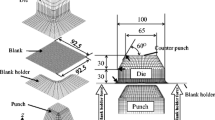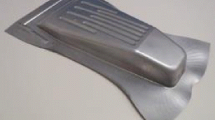Abstract
This paper presents a more accurate predictor-corrector scheme that combines the stream line method (SLM) and feasible sequential quadratic programming (FSQP) using the explicit dynamic finite element method (FEM) to design the optimum blank in the deep drawing process of square cup with flange. It is clear that faster convergence and better results of calculating optimum blank shape are guaranteed when FSQP uses a better initial guess. But it is not easy to guess the initial blank shape due to the variation of blank thickness, material anisotropy, and friction on the flange area at the beginning in the deep drawing process. SLM can obtain a preliminary prediction of the optimum blank shape with a little computational effort, so with SLM it is feasible to predict the initial guess of optimum blank with the assumption of fixed height of square cup with flange. FSQP can continue to adopt the predictor obtained by SLM to correct the optimum blank efficiently and accurately. Then the optimum blank is used in the final simulation and experiment. From comparison of the target shape between the simulated and experimental results, a good correspondence is confirmed. Other comparisons of the punch load, punch stroke, and wall thickness of the target square cup also show good agreement.
Similar content being viewed by others
References
Doege E (1985) Prediction of failure in deep drawing, computer modelling of sheet metal forming process: theory, verification and application. Proceedings of the 12th automotive material symposium, TMS-AIME, University of Michigan, Ann Arbor, MI, pp 209–224
Jimma T, Kuwabara T, Choi SC (1984) Researches on the deep drawing of re-entrant contour shells. Proceedings of the 1st international conference on technology of plasticity, Tokyo, vol 2, pp 1091–1096
Kawai N, Mori T, Hayashi H, Kondoh F (1987) Effects of punch cross-section on deep drawability of square shell of aluminum sheet. ASME J Eng Ind 109:355–361
Karima M (1989) Blank development and tooling design for drawn parts using a modified slip line field based on approach. ASME J Eng Ind 111(4):345–350
Zaky AM, Nassr AB, EI-Sebaie MG (1998) Optimum blank shape of cylindrical cups in deep drawing of anisotropic sheet metals. J Mater Process Technol 76:203–211
Hill R (1983) The mathematical theory of plasticity. Oxford University Press, Oxford
Chung K, Barlat F, Brem JC, Lege DJ, Richmond O (1997) Blank shape design for a planar anisotropic sheet based on ideal forming design theory and FEM analysis. Int J Mech Sci 39(1):105–120
Lo SW, Lee JY (1998) Optimum blank shapes for prismatic cup drawing- consideration of friction and material anisotropy. ASME Trans, J Manuf Sci Engn 120(2):306–315
Lu YH, Li CL, Lo SW (2001) A study of optimum blank for square cup drawing using stream line method. J Mater Process Technol 110:146–151
Joun MS, Hwang SM (1993) Optimal process design in steady-state metal forming by finite element method-I theoretical considerations. Int J Mach Tools Manuf 33(1):51–61
Joun MS, Hwang SM (1993) Optimal process design in steady-state metal forming by finite element method - II application to die shape design in extrusion. Int J Mach Tools Manuf 33(1):63–70
Gresovnik I (2000) A general purpose computational shell for solving inverse and optimization problems. PhD Thesis, University of Wales, UK
Zhao X, Zhao G, Wang G, Wang T (2002) Preform die shape for uniformity of deformation in forging based on preform sensitivity analysis. J Mater Process Tech 128:25–32
Sousa LC, Castro CF, Antonio CAC, Santos AD (2002) Inverse methods in design of industrial forging processes. J Mater Process Tech 128:266–273
Panier ER, Tits AL (1993) On combining feasibility, descent and superlinear convergence in inequality constrained optimization. Math Program 59:261–276
Bonnans JF, Panier ER, Tits AL, Zhou JL (1992) Avoiding the maratos effect by means of a nonmonotone line search. II Inequality constrained problems - feasible iterates. SIAM J Numer Anal 29:1187–1202
Zhou JL, Tits AL (1993) Nonmonotone line search for minimax problems. J Optim Theory Appl 76:455–476
Lu YH, Yeh FH, Li CL (2005) Application of FSQP to inverse estimation of the constitutive constants and friction coefficient in the nosing process. Materials Science Forum 506:685–690
Belytschko T, Liu WK, Moran B (2000) Nonlinear finite elements for continua and structures. Wiley, New York
Acknowledgements
The authors wish to thank professor Andre L. Tits from the Electrical Engineering Department at the University of Maryland, USA for his support and enthusiastic discussion on the feasible sequential quadratic programming. The authors also wish to thank professor Y. H. Lu from the Department of Mechanical Engineering at the National Ilan University, Taiwan for his discussion on the results of simulation and experiment.
Author information
Authors and Affiliations
Corresponding author
Rights and permissions
About this article
Cite this article
Yeh, FH., Li, CL. Optimum blank design by the predictor-corrector scheme of SLM and FSQP in the deep drawing process of square cup with flange. Int J Adv Manuf Technol 34, 277–286 (2007). https://doi.org/10.1007/s00170-006-0606-3
Received:
Accepted:
Published:
Issue Date:
DOI: https://doi.org/10.1007/s00170-006-0606-3




